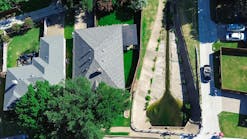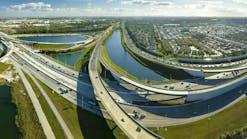Vegetation Victory: Managing Storm Water Runoff
About the author:
Scott Radford is a landscape architect for Stantec. Radford can be reached at [email protected].
Vegetation plays a vital role in protection against wind and water erosion and the management of storm water runoff. Scientific study of erosion and soil loss began in the early 20th century as a response to the damaging large agricultural practices throughout the Great Plains. Through decades of experimentation and study, the USDA National Resources Conservation Service (NRCS) developed the Universal Soil Loss Equation (USLE) in 1965. The Revised Universal Soil Loss Equation (RUSLE) was introduced in 1978. RUSLE2 was released in 2003 and is a further enhanced computer model soil loss equation.
RUSLE was based on erosion plot and rainfall simulator experiments. RUSLE2 is composed of six factors to predict long-term average annual soil loss. The equation includes rainfall erosivity factor, soil erodibility factor, slope length, slope steepness, vegetation management and erosion control practices.
While all these play a role in understanding the physical characteristics that contribute to soil erosion, the fundamental core to preventing and protecting against erosion is vegetation cover.
The Power of Plantings
The energy from raindrops striking the ground surface begins the erosion process. From the leaves, needles and branches of trees, to the foliage and flowers of shrubs, grasses and groundcovers, down to their root systems, all parts of vegetation help prevent and protect against soil erosion. More importantly, all play a role in both the water cycle and earth’s energy balance.
Have you ever walked outside after a storm and the ground seems dry but notice rainwater clinging to trees and shrubs? Or have you made your way through a forest and come out soaked, thanks to rain on the surrounding bushes? These are great examples of vegetation’s key role in erosion control — preventing rainwater from reaching the ground in the first place.
A well-designed and functioning landscape includes a deep layer (12 to 18 inch) of uncompacted organic rich topsoil and three layers of vegetation — canopy layer of trees, middle story of shrubs and lower story of ground cover. This combined with a 3- to 4-inch floor layer of duff or mulch form a robust natural system to protect against erosion.
Trees have an enormous capacity to intercept rainwater. Do not believe the adage that a tree is 90% air. Golf balls almost never pass through a tree canopy without striking a branch or leaf. The same goes for raindrops. A tree’s root system also significantly improves soil infiltration. Studies have found shallow fibrous roots improved infiltration by 19% and deeper tap root trees by 118% over the soils without trees. Species like maple, willow, aspen and birch have a large proportion of naturally spreading fine roots and are popular choices for slope stabilization.
The middle story layer further disperses water and is the first line of defense if there are no trees. Bushy and creeping shrubs have a thick woody structure deterring foot traffic and prevent the ground from becoming over compacted. Fibrous root systems improve and maintain infiltration. For example, a creeping shrub, like prostrate rosemary, has just one stem but spreads out in every direction with a carpet of foliage.
Low-lying creeping plants, typically called groundcover, grow a few to several inches tall. Their foliage covers the ground surface and root systems bind soil particles. Strawberry and mosses, along with native and ornamental grasses, are all excellent groundcover options.
Application of grass by methods like hand seeding, drill seeding or hydroseeding is often needed, or even required, at the completion of a project as a cost effective means to establish an initial layer of soil-hugging roots until plants mature. This quick cover reduces sediment and runoff in the first rainy season. It is common to plant a slope with container grown shrubs and groundcovers then apply hydroseed right over the top for both short- and long-term solutions.
The Value of Mulch
Vegetation is not the only solution. The value of a mulch layer cannot be stressed enough. Permanent landscape installations should have a 3- to 4-inch layer to absorb rain drop energy, slow runoff, promote infiltration and reduce evapotranspiration.
A coarse wood chip mulch, sometimes known as arborist mulch, is shown to provide significant benefit in terms of moisture retention, temperature moderation and weed control. Wood chip mulches have a chemical and physical diversity resisting the tendency towards compaction. The variation in material size slows the decomposition rate, creating a more diverse soil biota. Biologically diverse soil biota is more resistant to environmental disturbance and in turn supports a healthy plant population. For temporary protection measures, a 2-inch layer of straw provides good protection on bare ground.
RUSLE illustrates a slope’s influence on the rate water flows into or off soils. In steeper slope areas, newly planted vegetation does not have sufficient foliage or root systems to work right away. Erosion control blanket materials, such as jute netting or coconut coir, provide control until root systems mature.
Form & Function Restored
The Cedar Creek Culvert Replacement in Kirkland, Washington, was a fish passage and wetland improvement project constructed during the summer of 2020. Existing vegetation and a mass excavation of nearly two acres of land adjacent to Cedar Creek was tackled.
Prior to vegetation removal, temporary erosion and sediment control measures included silt fencing, straw wattles and mulch combined to create a protection barrier between the exposed soils and the creek edge and drainage pathways. Regular monitoring was required to ensure no soil escaped the site and entered the creek.
Work was performed during July and August — the driest months of the year. By mid-September, the new culvert and other structural improvements were complete, and preparation and installation of permanent vegetative surface restoration began.
First, the existing soils were decompacted with a rototiller — a critical restoration step. On steeper slopes, a tracked excavator with a tooth bucket scarified the surface to a depth of approximately 12 inches. Composted mulch improved not only soil organic content, but water holding and infiltration capacity.
Next, the surface was hand graded and roughened lightly and hydroseeded with a mixture of native seed and hydromulch. Together these formed the necessary elements to protect the newly restored soils. After seeding, all areas with slopes greater than 5H:1V received a coconut fiber erosion control fabric.
Once initial seed growth emerged, installation of more than 3,000 1-gallon tree and shrub plantings began. All planting holes received a 3- to 4-inch layer of coarse compost to help capture and hold moisture and suppress weed growth near the newly installed plants.
The vegetation restoration measures of decompacting soils, incorporating compost to reestablish a deep topsoil profile, erosion control fabric and installation of layers of vegetation work in concert to protect against soil erosion. As the fall rains of October and November began, the new vegetation succeeded in protecting against erosion now and long into the future.
This project serves as an example of how vegetation not only increases the beauty of the area but has an important job in maintaining the health of this important fish habitat. Engineers, designers and contractors have an obligation to understand and implement quality and well-functioning solutions to reduce erosion and manage storm water to improve water quality.






